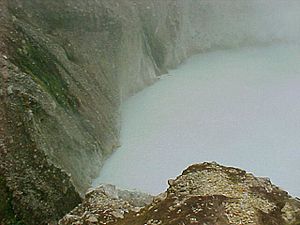Boiling point facts for kids

The boiling point of a substance is the temperature at which the substance boils, or enters a state of rapid evaporation. For pure water this is 100° Celsius or 212° Fahrenheit. This is measured at one atmosphere, that is, the air pressure at sea level
Boiling points can be changed in several ways. The addition of solutes or other substances usually changes the boiling point. Additionally, changing the pressure on a liquid changes its boiling point.
The boiling point of a liquid depends on the pressure of the surrounding air. An increase in air pressure increases the boiling point; a decrease decreases the boiling point. In the low pressure environment at the top of Mt Everest for example, water boils at only 69 °C. (156.2 °F). It can also be defined in terms of vapour pressure as the temperature at which vapour pressure of liquid becomes equal to atmospheric pressure
Sugar, salt or other non-volatile solutes in water will usually make the boiling point higher. Alcohol, in contrast, is a volatile chemical that lowers the boiling point of water. Even a large amount dissolved in the water will usually make only small changes in the boiling point.
See also
 In Spanish: Punto de ebullición para niños
In Spanish: Punto de ebullición para niños

